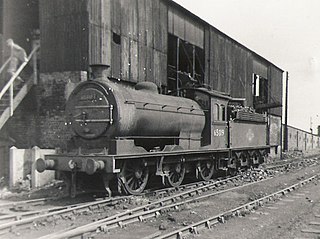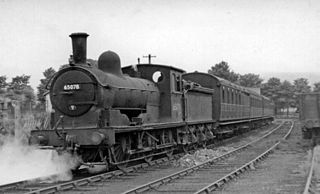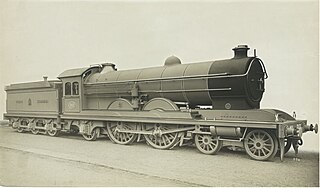
Sir Vincent Litchfield Raven, KBE was an English railway engineer, and was chief mechanical engineer of the North Eastern Railway from 1910 to 1922.

The Great Northern Railway (GNR) Small Boiler Class C1 is a class of steam locomotive, the first 4-4-2 or Atlantic type in Great Britain. They were designed by Henry Ivatt in 1897. In total 22 were built between 1898 and 1903 at Doncaster Works. The class were commonly known as 'Klondykes' [sic], after the 1897 Klondike gold rush. They could reach speeds of up to 90 mph. They were also known as Small Atlantics.

The London and North Eastern Railway Class J38 was a class of steam locomotive designed for freight transport. They were designed by Nigel Gresley and introduced in 1926. A total of 35 were built at the LNER's Darlington Works in 1926 and they were used in Scotland. All passed into British Railways ownership in 1948 and they were renumbered from 5900–5934 to 65900–65934.

The North Eastern Railway (NER) Class P3, classified J27 by the LNER, is a class of 0-6-0 steam locomotive. The P3 Class was designed by Wilson Worsdell and was a relatively minor modification of the existing North Eastern Railway Class P2. The most significant change was a deeper firebox with shallower sloping fire grate. This was achieved by raising the boiler slightly, and by reducing the clearance between the firebox and the rear axle. The P3 Class were a freight engine by nature and used for hauling long trains of freight.

The North Eastern Railway (NER) Class C1, was a class of 0-6-0 freight locomotives designed by T.W. Worsdell. They were used throughout the NER system, although particularly in Teesside between 1886 and 1962.

The North Eastern Railway Class S3, classified B16 by the LNER, was a class of 4-6-0 steam locomotive designed for mixed traffic work. It was designed by Vincent Raven and introduced in 1920. The earlier members of this class were fitted with Westinghouse Brakes - all of this equipment was removed during the 1930s.

The Furness Railway 21 class or "Larger Seagulls", were a class of eight 4-4-0 steam locomotives designed by W. F. Pettigrew and built by Sharp, Stewart and Company of Glasgow for the Furness Railway. Six were built in 1896, and two more in 1900. They were built to supersede the 120 class on the heavier and more important trains and were in turn replaced on the railway’s top trains with the 115 class in the 1920s. They had 6-foot-0-inch (1.829 m) diameter driving wheels with 18-by-24-inch cylinders.

The London and North Eastern Railway (LNER) Thompson Class L1 was a class of 2-6-4T steam locomotives designed by Edward Thompson. The prototype no. 9000 was built in 1945, but the remaining 99 were built under British Railways jurisdiction between 1948–1950. The prototype was well received, however the production batch were not, and all were withdrawn and scrapped between 1960 and 1962.

The North Eastern Railway Class E1, classified as Class J72 by the London and North Eastern Railway (LNER), is a class of small 0-6-0T steam locomotives designed by Wilson Worsdell for shunting. They had inside cylinders and Stephenson valve gear.

The first London and North Eastern Railway (LNER) Class A2 was a class of 4-6-2 steam locomotive designed by Vincent Raven for the North Eastern Railway. Two were built by the NER in 1922 before the grouping and another three by the LNER in 1924. Their LNER numbers were 2400–2404. All five locomotives were named by the LNER.

The North Eastern Railway (NER) Bogie Tank Passenger (BTP) locomotives were designed by Edward Fletcher in 1873. The locomotives were for hauling passenger services on branch lines. They had an 0-4-4 wheel layout and a total of 124 locomotives were built. They were designated G6 by the London and North Eastern Railway (LNER).

The North Eastern Railway (NER) Class Y 4-6-2T tank locomotives were designed whilst Wilson Worsdell was Chief Mechanical Engineer, but none were built until 1910 by which time Vincent Raven had taken over.

The North Eastern Railway Class S was a 4-6-0 type of steam locomotive designed for express passenger workings. The first example was built in 1899. They were very similar to the NER Class S1, except for the smaller wheels of the former.
The NER Class W1 was a 4-6-2T steam locomotive of the North Eastern Railway. The class was introduced in 1914 as a rebuild of Wilson Worsdell's NER Class W 4-6-0T. At the 1923 Grouping, they all passed to the London and North Eastern Railway, who placed them in their Class A6.

The Great Northern Railway (GNR) Class L1 was a 0-8-2T side tank steam locomotive designed by Henry Ivatt. It was originally designed for suburban passenger traffic on the Metropolitan City Lines.
The NER Class S1 was a class of 4-6-0 steam locomotives of the North Eastern Railway. It was designed by Wilson Worsdell and five locomotives were built between 1900 and 1901 at Gateshead works. The S1 was similar to the NER Class S but had larger driving wheels and a higher boiler pressure.
The NER Class F was a class of 4-4-0 steam locomotives of the North Eastern Railway. It was designed by Thomas William Worsdell and introduced in 1887.
The NER Class G was a class of 4-4-0 steam locomotives of the North Eastern Railway. It was designed by Thomas William Worsdell and introduced in 1887.
The NER 398 Class was a class of 0-6-0 freight steam locomotive of the North Eastern Railway, designed by Edward Fletcher. in 1872. A total of 326 locomotives-of the class were built for the NER.

The NER Class Z was an Atlantic class of locomotives designed by Vincent Raven. It was introduced in 1911.















